Situational Awareness: The Effect of Stimulus Type and Hearing Protection on Sound Localization
Abstract
:1. Introduction
2. Materials and Methods
2.1. Participants
2.2. Stimuli
2.3. Hearing Protection Devices
2.4. Apparatus
2.5. Procedure
2.6. Data Analysis
3. Results
3.1. Discrimination Accuracy
3.1.1. No-HPD (Baseline)
3.1.2. With-HPD
3.2. Mirror Image Reversal Errors
3.2.1. No-HPD (Baseline)
3.2.2. With-HPD
4. Discussion
Author Contributions
Funding
Institutional Review Board Statement
Informed Consent Statement
Data Availability Statement
Acknowledgments
Conflicts of Interest
References
- Gelfand, S.A. Hearing: An Introduction to Psychological and Physiological Acoustics; CRC Press: New York, NY, USA, 2017. [Google Scholar]
- Litovsky, R. Development of the Auditory System. In Handbook of Clinical Neurology; Elsevier: Waltham, MA, USA, 2015; Volume 129, pp. 55–72. [Google Scholar]
- Yost, W.A.; Zhong, X. Sound source localization identification accuracy: Bandwidth dependencies. J. Acoust. Soc. Am. 2014, 136, 2737–2746. [Google Scholar] [CrossRef] [PubMed]
- Noble, W.G.; Russell, G. Theoretical and practical implications of the effects of hearing protection devices on localization ability. Acta Otolaryngol. 1972, 74, 29–36. [Google Scholar] [CrossRef]
- Abel, S.M.; Tsang, S.; Boyne, S. Sound localization with communications headsets: Comparison of passive and active systems. Noise Health 2007, 9, 101–108. [Google Scholar] [CrossRef]
- Abel, S.M.; Boyne, S.; Roesler-Mulroney, H. Sound localization with an army helmet worn in combination with an in-ear advanced communications system. Noise Health 2009, 11, 199–205. [Google Scholar] [CrossRef]
- Borg, E.; Bergkvist, C.; Bagger-Sjöbäck, D. Effect on directional hearing in hunters using amplifying (level dependent) hearing protectors. Otol. Neurotol. 2008, 29, 579–585. [Google Scholar] [CrossRef] [PubMed]
- Brungart, D.S.; Kordik, A.J.; Simpson, B.D.; McKinley, R.L. Auditory localization in the horizontal plane with single and double hearing protection. Aviat. Space Environ. Med. 2003, 74, 937–946. [Google Scholar] [CrossRef]
- Vause, N.L.; Grantham, D.W. Effects of earplugs and protective headgear on auditory localization ability in the horizontal plane. Hum. Factors 1999, 41, 282–294. [Google Scholar] [CrossRef] [PubMed]
- Dorman, M.F.; Natale, S.; Loiselle, L. Speech understanding and sound source localization by cochlear implant listeners using a pinna-effect imitating microphone and an adaptive beamformer. J. Am. Acad. Audiol. 2018, 29, 197–205. [Google Scholar] [CrossRef] [PubMed]
- Jones, H.; Kan, A.; Litovsky, R.Y. Comparing sound localization deficits in bilateral cochlear-implant users and vocoder simulations with normal-hearing listeners. Trends Hear. 2014, 18, 1–16. [Google Scholar] [CrossRef]
- Potts, L.G.; Skinner, M.W.; Litovsky, R.A.; Strube, M.J.; Kuk, F. Recognition and localization of speech by adult cochlear implant recipients wearing a digital hearing aid in the nonimplanted ear (bimodal hearing). J. Am. Acad. Audiol. 2009, 20, 353–373. [Google Scholar] [CrossRef] [Green Version]
- Brown, A.D.; Beemer, B.T.; Greene, N.T.; Argo IV, T.; Meegan, G.D.; Tollin, D.J. Effects of active and passive hearing protection devices on sound source localization, speech recognition, and tone detection. PLoS ONE 2015, 10, e0136568. [Google Scholar] [CrossRef] [Green Version]
- Brungart, D.S.; Kordik, A.J.; Simpson, B.D. The effects of single and double hearing protection on the localization and segregation of spatially-separated speech signals (L). J. Acoust. Soc. Am. 2004, 116, 1897–1900. [Google Scholar] [CrossRef] [Green Version]
- Joubaud, T.; Zimpfer, V.; Garcia, A.; Langrenne, C. Sound localization models as evaluation tools for tactical communication and protective systems. J. Acoust. Soc. Am. 2017, 141, 2637–2649. [Google Scholar] [CrossRef]
- Fink, N.; Pikkel, H.Z.; Eisenkraft, A.; Banta, G.A. Hearing protection devices and methods used for their evaluation: A military perspective. J. Mil. Veteran Fam. Health 2019, 5, 141–147. [Google Scholar] [CrossRef]
- Yost, W.A. Sound source localization identification accuracy: Level and duration dependencies. J. Acoust. Soc. Am. 2016, 140, EL14–EL19. [Google Scholar] [CrossRef] [PubMed] [Green Version]
- Middlebrooks, J.C. Auditory space processing: Here, there or everywhere? Nat. Neurosci. 2002, 5, 824–826. [Google Scholar] [CrossRef] [PubMed]
- Stevens, S.S.; Newman, E.B. The localization of actual sources of sound. Am. J. Psychol. 1936, 48, 297–306. [Google Scholar] [CrossRef]
- Ihlefeld, A.; Shinn-Cunningham, B.G. Effect of source spectrum on sound localization in an everyday reverberant room. J. Acoust. Soc. Am. 2011, 130, 324–333. [Google Scholar] [CrossRef]
- Middlebrooks, J.C. Narrow-band sound localization related to external ear acoustics. J. Acoust. Soc. Am. 1992, 92, 2607–2624. [Google Scholar] [CrossRef]
- Blauert, J. Spatial Hearing: The Psychophysics of Human Sound Localization; MIT Press: Cambridge, MA, USA, 1997. [Google Scholar]
- Chau, W.; Duda, R.O. Combined monaural and binaural localization of sound sources. Proc. Asilomar. 1996, 2, 1281–1285. [Google Scholar]
- Davis, R.J.; Stephens, S.D.G. The effect of intensity on the localization of different acoustical stimuli in the vertical plane. J. Sound Vib. 1974, 35, 223–229. [Google Scholar] [CrossRef]
- Shigeno, S.; Oyama, T. Localization of speech and non-speech sounds. Jpn. Psychol. Res. 1983, 25, 112–117. [Google Scholar] [CrossRef] [Green Version]
- Simpson, B.D.; Bolia, R.S.; McKinley, R.L.; Brungart, D.S. The impact of hearing protection on sound localization and orienting behavior. Hum. Factors 2005, 47, 188–198. [Google Scholar] [CrossRef] [PubMed]
- Dobreva, M.S.; O’Neill, W.E.; Paige, G.D. Influence of aging on human sound localization. J. Neurophysiol. 2011, 105, 2471–2486. [Google Scholar] [CrossRef] [Green Version]
- Gordon, M.S.; Russo, F.A.; MacDonald, E. Spectral information for detection of acoustic time to arrival. Atten. Percept. Psychophys. 2013, 75, 738–750. [Google Scholar] [CrossRef] [Green Version]
- Rychtáriková, M.; Chmelik, V.; Roozen, N.B.; Glorieux, C. Front–back localization in simulated rectangular rooms. Appl. Acoust. 2015, 90, 143–152. [Google Scholar] [CrossRef]
- Yost, W.A.; Loiselle, L.; Dorman, M.; Burns, J.; Brown, C.A. Sound source localization of filtered noises by listeners with normal hearing: A statistical analysis. J. Acoust. Soc. Am. 2013, 133, 2876–2882. [Google Scholar] [CrossRef] [PubMed] [Green Version]
- Abel, S.; Burrell, C.; Saunders, D. The Effects of Integrated Hearing Protection Surround Levels on Sound Localization, Scientific Report; DRDC-RDDC2015-R012; Defense Research and Development Canada: Ottawa, ON, Canada, 2015.
- Alali, K.; Casali, J.G. Auditory backup alarms: Distance-at-first-detection via in-situ experimentation on alarm design and hearing protection effects. Work 2012, 41 (Suppl. 1), 3599–3607. [Google Scholar] [CrossRef] [Green Version]
- Lee, K.; Casali, J.G. Development of an auditory situation awareness test battery for advanced hearing protectors and TCAPS: Detection subtest of DRILCOM (detection-recognition/identification-localization-communication). Int. J. Audiol. 2017, 56 (Suppl. 1), 22–33. [Google Scholar] [CrossRef]
- Talcott, K.A.; Casali, J.G.; Keady, J.P.; Killion, M.C. Azimuthal auditory localization of gunshots in a realistic field environment: Effects of open-ear versus hearing protection-enhancement devices (HPEDs), military vehicle noise, and hearing impairment. Int. J. Audiol. 2012, 51 (Suppl. 1), S20–S30. [Google Scholar] [CrossRef]
- Sintonizar Productions and TheWhiteKnuckleFilms. Real life Gunshot Sound Effects. Gunshot Sound Effect. ASMR. YouTube. Available online: https://www.youtube.com/watch?v=1N_m3tsPyP0 (accessed on 10 October 2021).
- Middlebrooks, J.C. Individual differences in external-ear transfer functions reduced by scaling in frequency. J. Acoust. Soc. Am. 1999, 106, 1480–1492. [Google Scholar] [CrossRef] [PubMed]
- Laroche, C.; Giguère, C.; Vaillancourt, V.; Marleau, C.; Cadieux, M.F.; Laprise-Girard, K.; Gula, E.; Carroll, V.; Bibeau, M.; Nélisse, H. Effect of hearing and head protection on the localization of tonal and broadband reverse alarms. Hum. Factors 2021. [Google Scholar] [CrossRef] [PubMed]
- Derey, K.; Rauschecker, J.P.; Formisano, E.; Valente, G.; de Gelder, B. Localization of complex sounds is modulated by behavioral relevance and sound category. J. Acoust. Soc. Am. 2017, 142, 1757–1773. [Google Scholar] [CrossRef] [PubMed]
- Yost, W.A. Sound source localization identification accuracy: Envelope dependencies. J. Acoust. Soc. Am. 2017, 142, 173–185. [Google Scholar] [CrossRef]
- Yehudai, N.; Fink, N.; Shpriz, M.; Marom, T. Acute acoustic trauma among soldiers during an intense combat. J. Am. Acad. Audiol. 2017, 28, 436–443. [Google Scholar] [CrossRef] [PubMed]

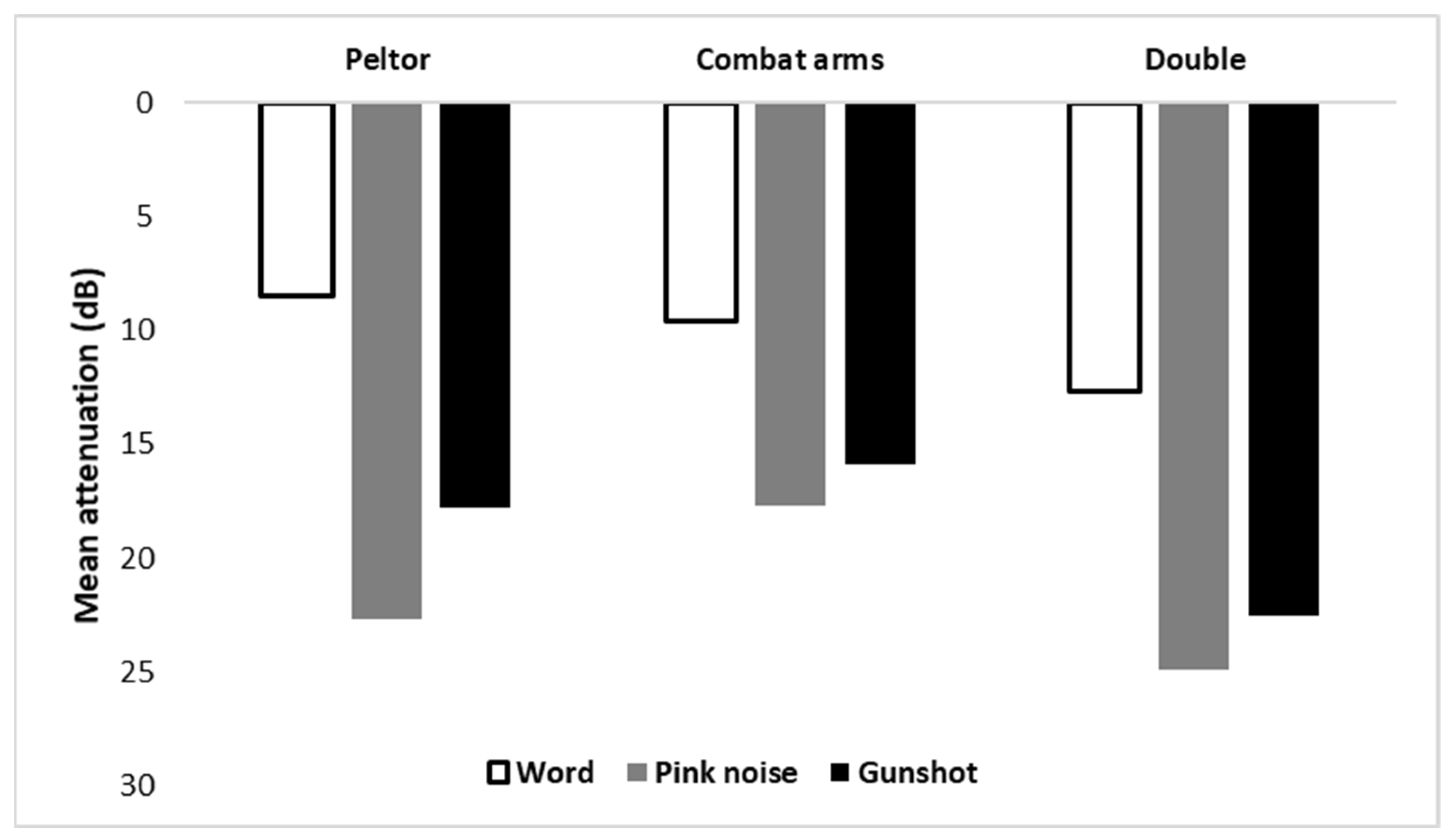
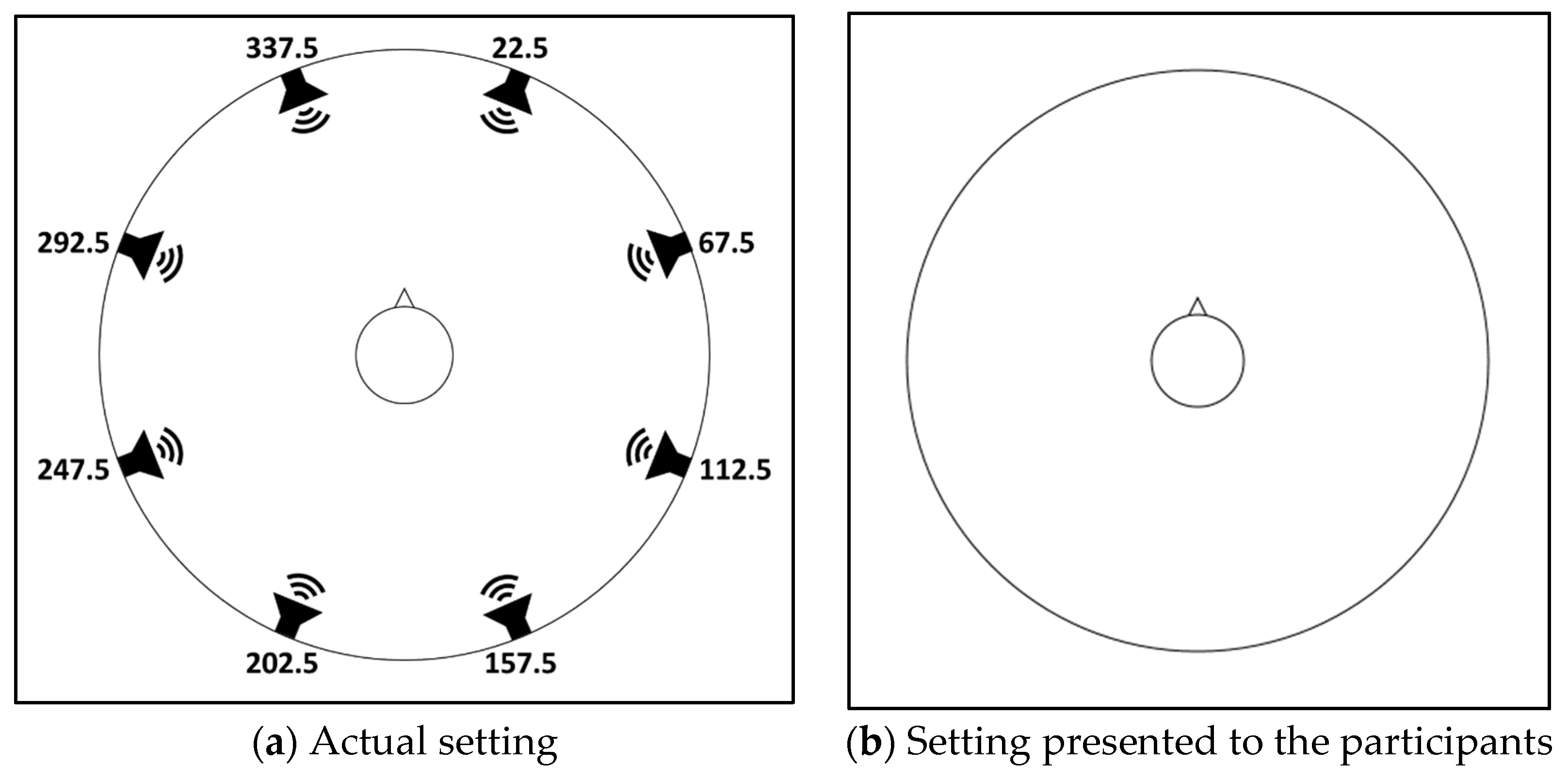
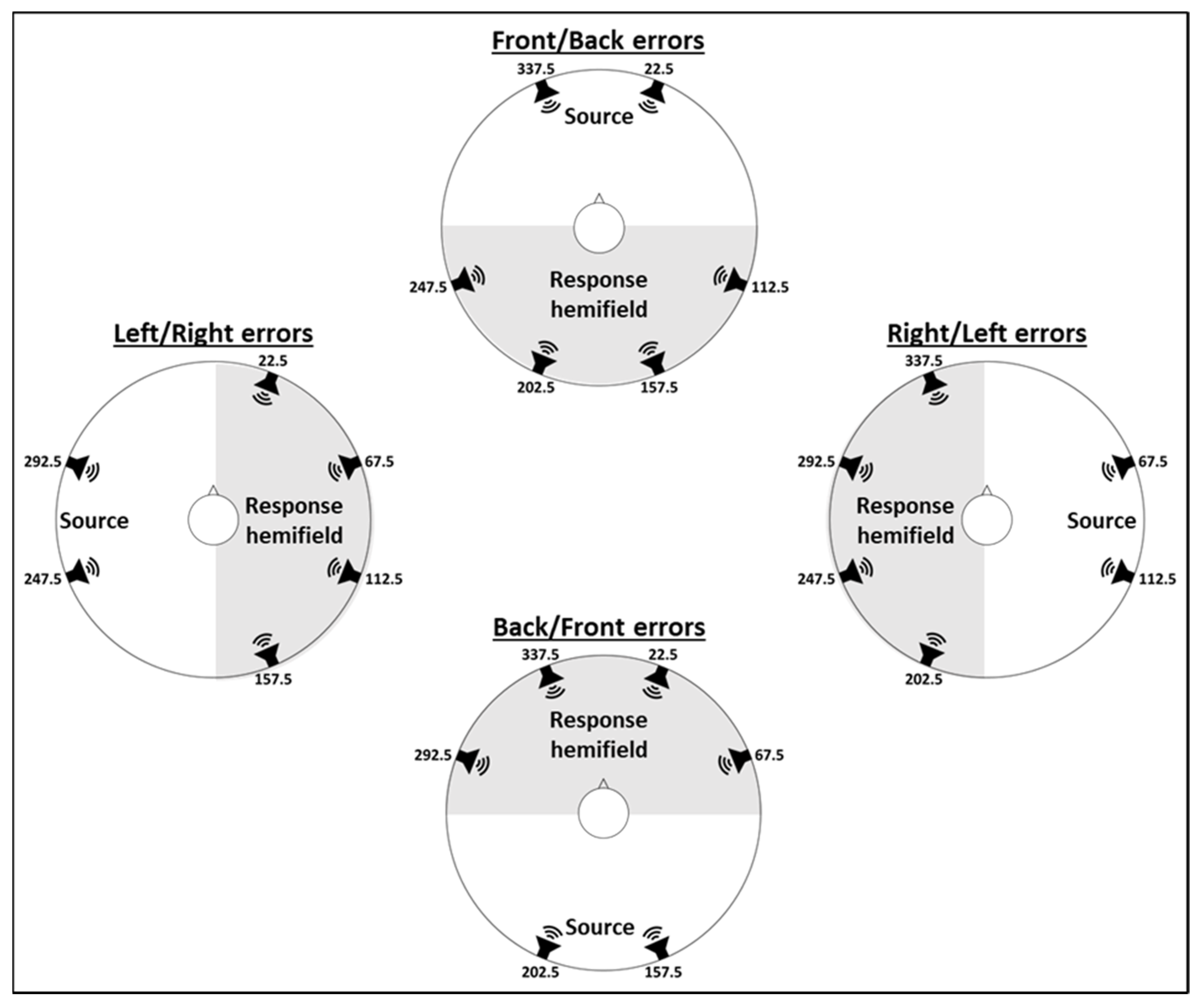

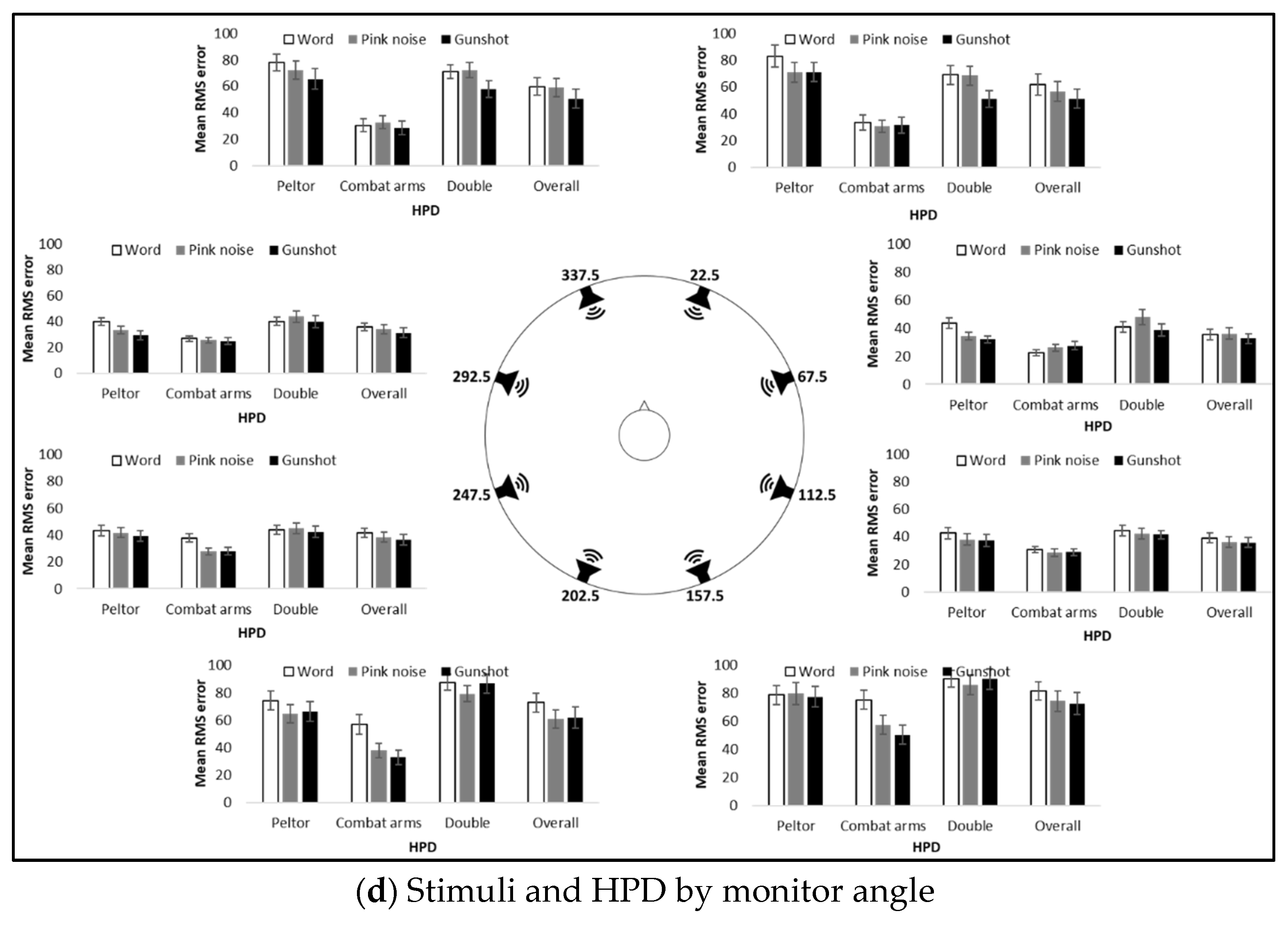
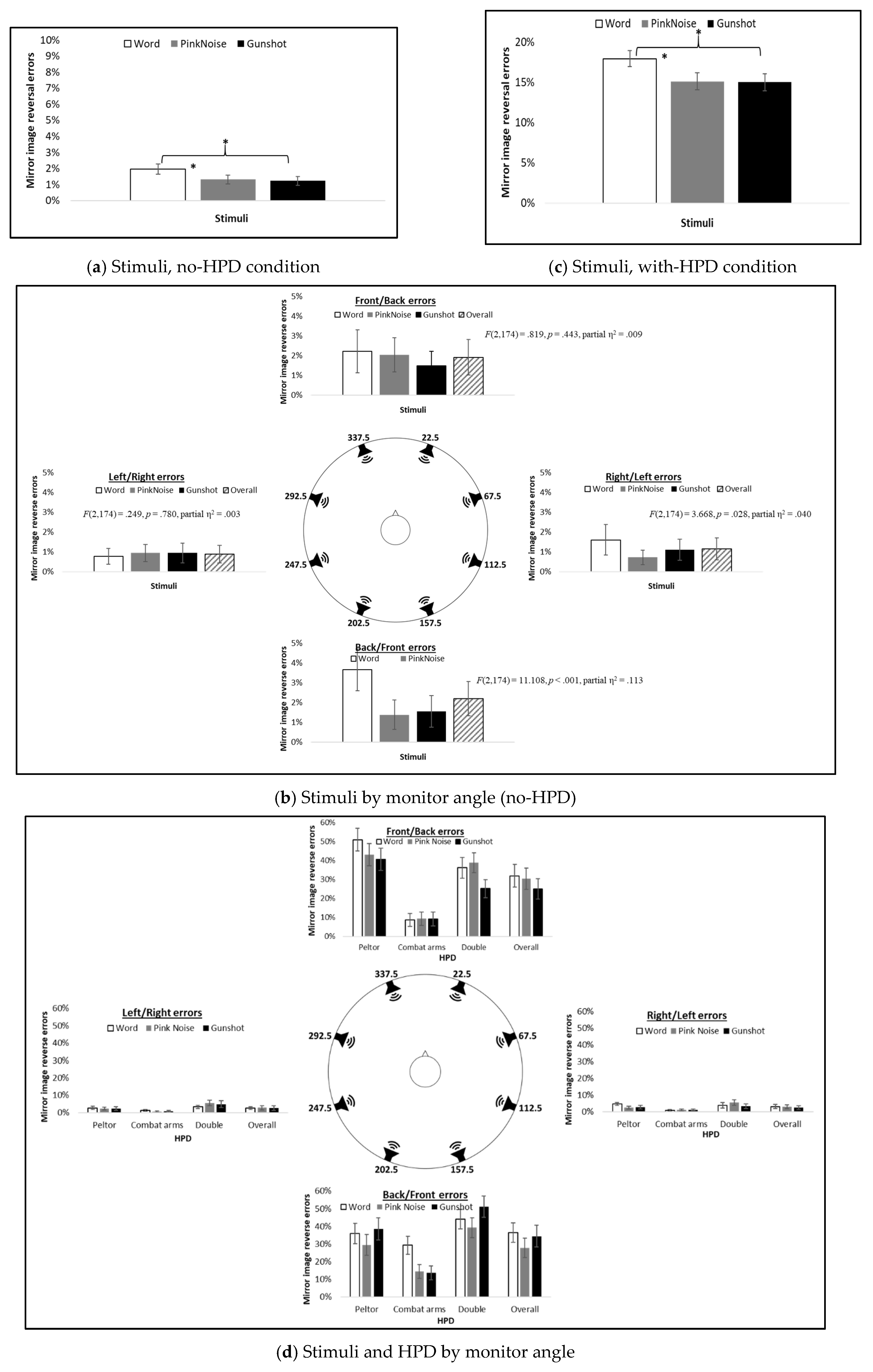
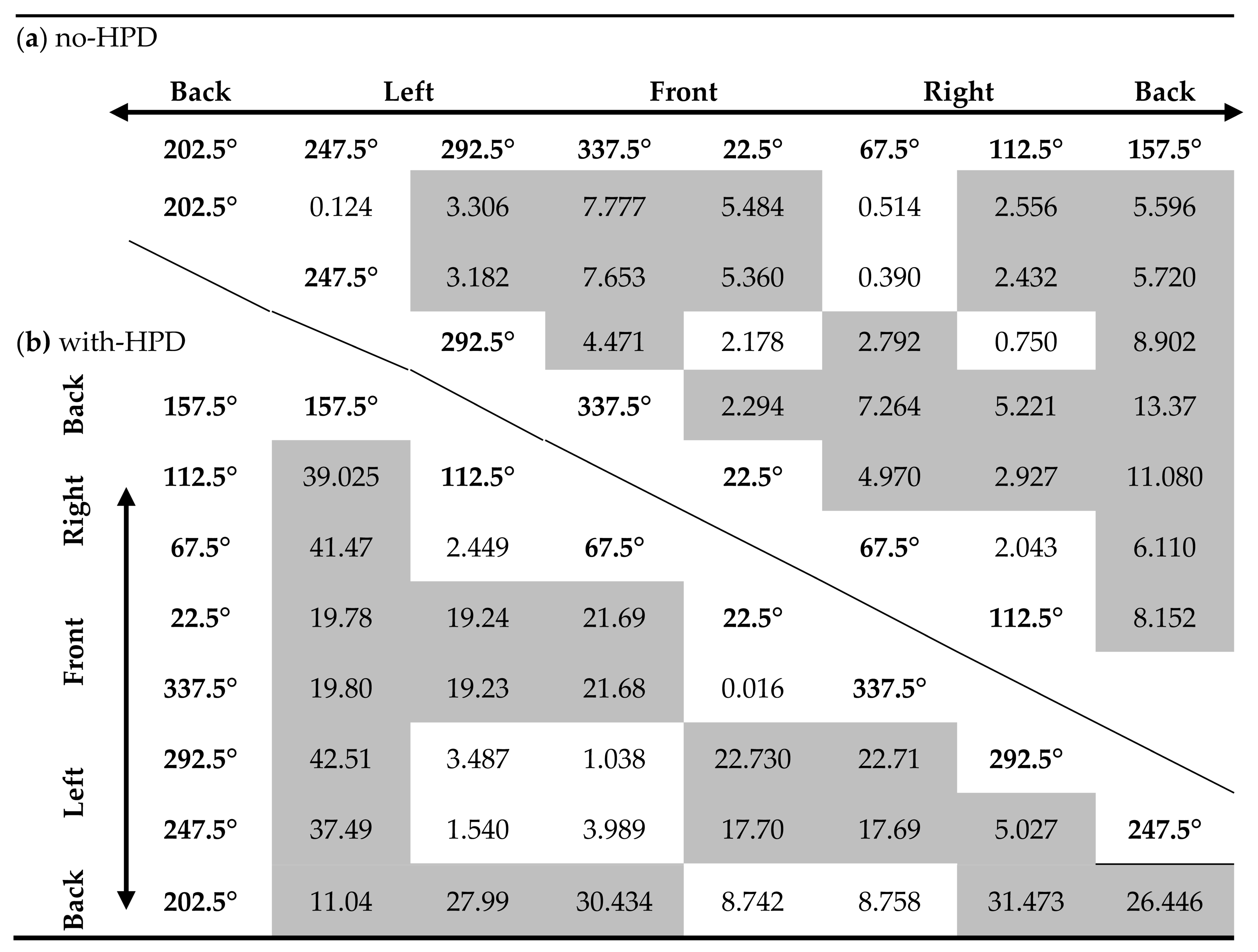

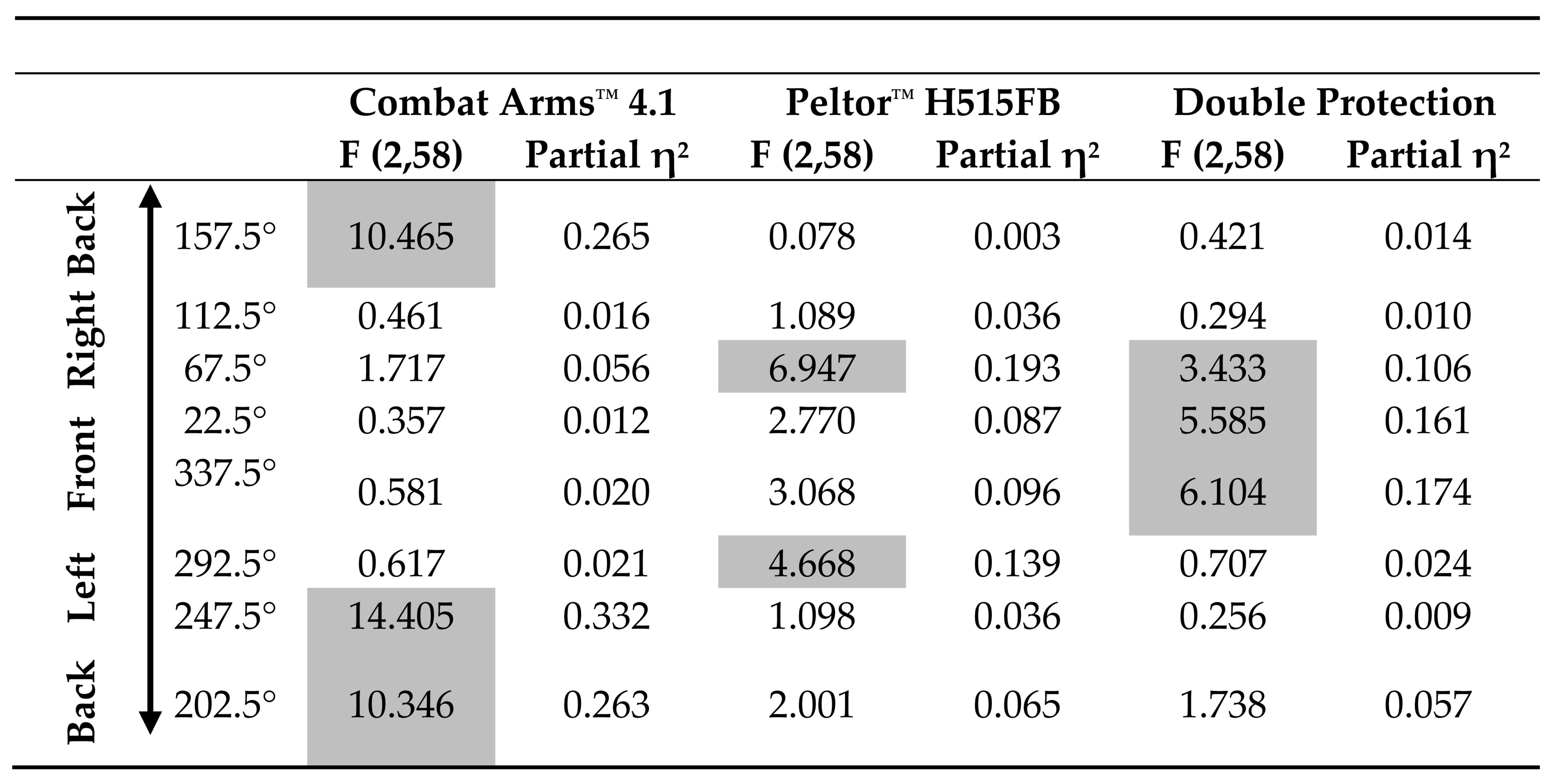
| Combat Arms™ 4.1 | Peltor™ H515FB | Double Protection | ||||||||
|---|---|---|---|---|---|---|---|---|---|---|
| Word vs. Pink Noise | Word vs. Gunshot | Pink Noise vs. Gunshot | Word vs. Pink Noise | Word vs. Gunshot | Pink Noise vs. Gunshot | Word vs. Pink Noise | Word vs. Gunshot | Pink Noise vs. Gunshot | ||
| Back | 157.5° | 17.744 | 24.854 | 7.110 | −1.125 | 1.124 | 2.249 | 4.636 | 0.418 | −4.219 |
| Right | 112.5° | 2.108 | 1.834 | −0.274 | 4.634 | 5.376 | 0.742 | 2.147 | 2.815 | 0.668 |
| 67.5° | −3.403 | −4.789 | −1.386 | 9.263 | 11.597 | 2.334 | −7.114 | 2.182 | 9.297 | |
| Front | 22.5° | 2.962 | 2.063 | −0.899 | 12.268 | 12.115 | −0.153 | 0.538 | 17.849 | 17.312 |
| 337.5° | −2.300 | 1.817 | 4.117 | 5.659 | 12.485 | 6.826 | −1.102 | 13.360 | 14.462 | |
| Left | 292.5° | 1.400 | 2.282 | 0.882 | 6.486 | 10.542 | 4.055 | −3.730 | −0.010 | 3.720 |
| 247.5° | 9.916 | 10.089 | 0.173 | 1.456 | 4.119 | 2.662 | −1.316 | 1.340 | 2.656 | |
| Back | 202.5° | 18.819 | 23.774 | 4.955 | 9.445 | 7.831 | −1.614 | 8.445 | 0.983 | −7.462 |

| (a) no-HPD | ||||
| L/R | F/B | B/F | R/L | |
| Word vs. pink noise 1 | −0.002 | 0.002 | 0.023 | 0.009 |
| Word vs. gunshot 1 | −0.002 | 0.007 | 0.021 | 0.005 |
| Pink noise vs. gunshot 1 | −0.001 | 0.006 | −0.002 | −0.004 |
| (b) with-HPD | ||||
| L/R | F/B | B/F | R/L | |
| Peltor™2 | 0.027, 0.001 | 4.234, 0.127 | 3.830, 0.117 | 0.514, 0.017 |
| Word vs. pink noise 1 | 0.001 | 0.080 | 0.065 | 0.008 |
| Word vs. gunshot 1 | 0.001 | 0.103 | −0.027 | 0.006 |
| Pink noise vs. gunshot 1 | 0.007 | 0.023 | −0.092 | −0.002 |
| Combat Arms™ 2 | 0.635, 0.021 | 0.099, 0.003 | 11.387, 0.282 | 0.125, 0.004 |
| Word vs. pink noise 1 | 0.003 | −0.007 | 0.148 | 0.000 |
| Word vs. gunshot 1 | 0.002 | −0.005 | 0.157 | −0.002 |
| Pink noise vs. gunshot 1 | −0.002 | 0.002 | 0.008 | −0.002 |
| Double protection 2 | 0.329, 0.011 | 6.415, 0.181 | 4.258, 0.128 | 3.083, 0.096 |
| Word vs. pink noise 1 | −0.009 | −0.027 | 0.047 | −0.013 |
| Word vs. gunshot 1 | −0.003 | 0.110 | −0.072 | 0.009 |
| Pink noise vs. gunshot 1 | 0.007 | 0.137 | −0.118 | 0.022 |
Publisher’s Note: MDPI stays neutral with regard to jurisdictional claims in published maps and institutional affiliations. |
© 2021 by the authors. Licensee MDPI, Basel, Switzerland. This article is an open access article distributed under the terms and conditions of the Creative Commons Attribution (CC BY) license (https://creativecommons.org/licenses/by/4.0/).
Share and Cite
Fostick, L.; Fink, N. Situational Awareness: The Effect of Stimulus Type and Hearing Protection on Sound Localization. Sensors 2021, 21, 7044. https://doi.org/10.3390/s21217044
Fostick L, Fink N. Situational Awareness: The Effect of Stimulus Type and Hearing Protection on Sound Localization. Sensors. 2021; 21(21):7044. https://doi.org/10.3390/s21217044
Chicago/Turabian StyleFostick, Leah, and Nir Fink. 2021. "Situational Awareness: The Effect of Stimulus Type and Hearing Protection on Sound Localization" Sensors 21, no. 21: 7044. https://doi.org/10.3390/s21217044
APA StyleFostick, L., & Fink, N. (2021). Situational Awareness: The Effect of Stimulus Type and Hearing Protection on Sound Localization. Sensors, 21(21), 7044. https://doi.org/10.3390/s21217044







